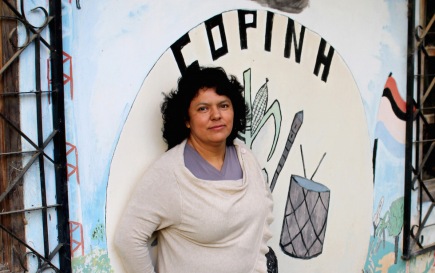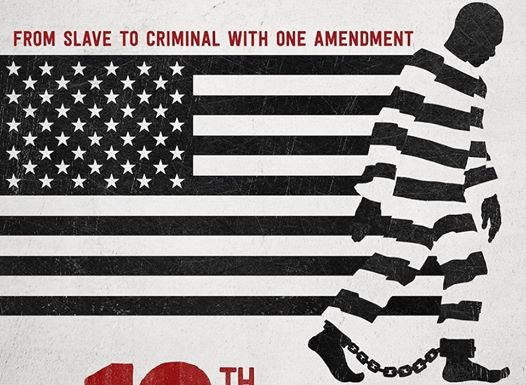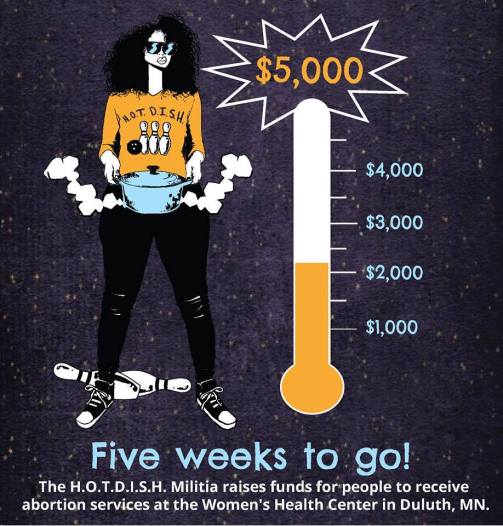March Activist Notes
March Activist Notes
H. Bradford
3/31/17
March was another busy month! I can’t believe that it is already over. Now, I didn’t attend every event that happened this month. That would be impossible. I also didn’t attend every event that I could have attended this month. That would require a revolutionary zeal that I simply don’t possess. I took time to bird watch, paint bird houses, edit a book I have been working on, and attend the ballet. I also took walks, wasted time, and socialized. So, this sample is not all of the events that happened in the Northland this month. It is not even the most important events that happened this month! It is a sample of a few things that transpired so that those who missed them can get an idea of what they missed out on.
Berta Vive in Duluth: March 5th
Berta Caceres was assassinated on March 2nd, 2016. She was an indigenous environmental activist who stood up against the neoliberal plot to build a hydroelectric dam in Rio Blanco, Honduras. Following the 2009 coup which Hilary Clinton’s state department legitimized if not supported, violence against activists has increased. Caceres, a critic of Clinton, was one of many victims of this violence. Witness for Peace is taking a delegation to Honduras this spring, so in honor of Berta, but also to promote the upcoming trip, they hosted this event. The event featured a panel of previous Witness for Peace delegates. This was a great way to start International Women’s Day week, since it connected the struggles of women in other countries to our own brutal foreign policy. Feminism should be for everyone, not just American women. Our foreign policy is anathema to feminism.

International Women’s Day: March 8th
On March 8th, the Feminist Justice League hosted a 78 minute symbolic strike in solidarity with International Women’s Day events around the world. The strike was meant to highlight the wage gap between men and women. If one compares the median income of a man versus a woman, women make about 80% of the income that men make on average in a year (80% is the newest statistic, but 78 is still often quoted). There are many reasons for this. For one, women are not valued, so their labor is less valued. Careers which attract women tend to be lower paid and less esteemed. Because the United States is one of the few countries in the world which does not provide paid maternity leave, women must leave the labor force when they have children. This also diminishes wages. Women are more likely to do unpaid labor and care for children as single parents. This too, diminishes their economic power. It was extremely cold and windy on March 8th, but a few dozen intrepid protestors braved the cold for the whole 78 minutes. At various intervals, we banged on a pot and announced the wage gap between various racial minorities and white men. The banging on the pot was met with “boos!” as we expressed our outrage over the racist, ageist, and sexist wage gap. Black women make about 63% of the median income of white men and Hispanic women make 54%. Native Hawaiians/Pacific Islanders make 60% of the income of white men and Native Americans make 58%. Women over the age of 55 make about 74% of the income of white men the same age. Wage parity is important since it highlights the economic foundations of sexism (and for that matter racism). The event was followed by a panel discussion, which explored other facets of labor. I especially enjoyed when Ariel spoke about sex work and stripping. She provided a balanced view of the pros and cons of the industry, her struggles and successes as a stripper (especially with stigma), and a call to legitimize all the work women do. Kristi provided great information about Earned Safe and Sick Time in Duluth and Katie Humphrey spoke about how women benefit from unions. A great discussion followed. On April 4th, there will be another wage parity event in Duluth, hosted by AAUW.

Feminist Frolic: Labor History Walk + Discussion
Once a month, the Feminist Justice League hosts a feminist frolic, which involves an outdoor activity and a discussion. This month, Adam was going to present on the labor history of Superior while doing a short walk. Only three people showed up, so we decided to table the event for a later time. However, about an hour later, two more people showed up, so I did a presentation of socialist feminism at the Solidarity House.
13th Documentary: March 13
Superior Save the Kids hosted a documentary showing of 13th. I enjoyed that the documentary was dense with history and information, yet easily digestible. It wove a tight narrative of how the criminal justice system is fundamentally racist. For instance, African Americans make up 6.5% of our population, but 40% of the prison population. It is startling to think that there are more prisoners today then there were slaves during the Civil War. The United States is 5% of the world’s population, but hosts 25% of the world’s prison population. According to the film, the rise of the prison industry was a way to profit while oppressing racial minorities (and really everyone as we are all to varying degrees oppressed by a system that divides us, threatens us, and profits from our punishment). To this end, the “scary black man” had to be invented. Thus, around the turn of the last century, a narrative that black men were rapists, out of control, and associated with criminality was concocted. This narrative legitimized the KKK and racist mobs (such as the racist mob which hung Clayton, Jackson, and McGhie in Duluth). The Civil Rights movement challenged outright violence against and segregation of black people, but violence and segregation have continued through the criminal justice system. For instance, in 1970, the prison population was about 350,000 people. Today, there are states with higher prison populations than that number! By 1980, there were 500,000 people in prison. The war on drug, which penalized crack cocaine harder than other drugs, as well as cuts to social programs, ushered in an era of explosive prison population growth. By the mid 1980s, over 700,000 people were imprisoned. By 1990, the number was over one million. In 2000, the number reached 2 million. The Clintons were complicit in this surge, as Bill Clinton wanted to be tough on crime. Through his Crime Bill and other polices, he supported extra police, the militarization of the police, the construction of extra prisons, mandatory minimum sentences, truth in sentencing (which limits parole), etc. Hillary called black youth “super preditors.” I have no illusions with the Democratic party. But, to be fair, Trump wanted the death penalty for youth. The movie also pointed out that the mass incarceration of African Americans has resulted in a crisis of leadership or less ability to organize themselves for their own rights. There was also information about ALEC, for profit prisons, and the movement of individualizing prison through GPS tracking/ankle bracelets. I had to work that night, so I missed the discussion, but it was a powerful and informative film. Save the Kids hopes to continue to show films on a monthly basis. On April 10th, Selma will be shown.

Bi with (Pizza) Pie: Trans in Prison- March 20th
Each month, Pandemonium, the local Bi+ group gets together for a presentation on a topic. This month, Lucas Dietsche led the discussion with a presentation on the challenges that trans individuals face in the criminal justice system. He gave a very informed and engaging presentation on this topic. Some of the challenges include getting sent to a prison that misgenders the individual (so typically transwomen end up in men’s prisons or transwomen in men’s prisons), lack of access to hormones or other treatments, sexual assault, solitary confinement, lack of access to gender specific items such as bras, solitary confinement, and use of a legal name rather than preferred name or pronouns. When writing to trans prisoners, Lucas noted that the writer can not address the envelope or letter to the preferred name of the individual. The DOC requires that senders must use the legal name of the prisoner. He also noted that the DOC does not track trans individuals since it does not view them as trans. Rather, it lists them as their legal or birth sex. Thus, it is hard to know exactly how many trans individuals are in the prison system as the system renders them invisible. Lucas also mentioned some examples of trans people in prison or who have been in prison, such as Cece McDonald and Chelsea Manning. In the future, we would like to host an LGBTQ Letters to Prisoners Event.

UMD Women and Gender Studies Presentation: March 21st
I was invited to speak at a Feminist Activism and Community Organizing Class at UMD. This was a great experience. I spent the hour speaking about how theory informs the organizational tools that I chose to utilize as a feminist. I spoke about socialist feminism and my focus on building mass movements over electoral politics. The coolest part was that one of the students had read one of my blog posts prior to my visit to the class!
Socialism and a Slice: March 27
One a month, Socialist Action hosts Socialism and a Slice. This is an event for local activists to get together and enjoy pizza while discussing current events. At this meeting, Henry Banks provided us with some information about Uber. He made a strong argument against Uber on the basis that it is not regulated, it can drive up the price of taxis, and that taxis themselves are often utilized by people of color and low income individuals (contrasted with Uber which has more middle class white appeal). Taxi companies are more likely to be unionized than Uber and Adam R. pointed out that during Trump’s immigration ban, Uber continued providing ride services while NY taxi drivers were on strike. Later, Uber undercut taxi drivers who returned to work by turning off surge pricing (that is, when taxi demand goes up, prices tend to go up). This disgusting scabbing should be enough to turn a person off of Uber for good, as it seems that Uber only supports society’s “ubers” and uber profits. Unfortunately, Duluth’s City Council passed a resolution in support of ride share companies later that night.
Homeless Bill of Rights:
The Homeless Bill of Rights meets each Thursday at 6:30 at Dorothy Day House. I did not become involved with the group until October, but the organization has been tirelessly and relentlessly working on this issue since 2013. Finally, after all this time, the Homeless Bill or Rights is finally moving forward. Two important things happened this month. Firstly, the Duluth City Council voted that they wanted to move forward or for action to occur related to the bill. Although this doesn’t mean too much, it does mean that they are looking to see some sort of progress on this issue in the future and are committed to being a part of that. Another hopeful turn of events is that the Human Rights Commission voted to support the language and eleven points of the Homeless Person’s Bill of Rights. They also support this as an ordinance or a template for moving forward with an ordinance. This does not mean that this will be the ordinance that the City Council eventually vote on, as this requires further negotiation. However, it is a nice step forward.
 This is a promotional photo taken by the Homeless Person’s Bill of Rights Coalition. The featured individual is an activist who is engaged in this campaign and who has spoken about her experiences (Shareeka), though many individuals had their photos taken to promote the ordinance.
This is a promotional photo taken by the Homeless Person’s Bill of Rights Coalition. The featured individual is an activist who is engaged in this campaign and who has spoken about her experiences (Shareeka), though many individuals had their photos taken to promote the ordinance.
Hotdish Militia:
The Hotdish Militia has continued to meet each Thursday at 5:30. The big project that the group is working on is a Bowl-a-thon to raise funds in support of local abortion access at the Women’s Health Center. The funds go directly to local, low income women (or possibly men/trans/gender non-binary) so they can afford an abortion or other reproductive health care. Right now, we are working on raising funds, but also soliciting businesses for prizes to award the teams. The bowling event will be held on April 29th. Thus far, the fundraiser has raised over 2000 dollars. The goal is $5000. My own modest team, The Feminist Justice League, has raised over $400. While we are not the biggest fundraisers, I am proud that we have raised anything at all and thankful to the donors who have supported us!
to support us: https://bowl.nnaf.org/team/106832

Doctrine of Discovery: 3/30/17
Peace United Church hosted a showing of the documentary, Doctrine of Discovery. The film is about how Papal law from the late 1400s has been used to justify the denial of land rights and self-determination of Native Americans. Catholic law has been the basis of U.S. policy regarding Native Americans throughout our entire history. Basically, Catholics did not recognize the right of Native Americans to own their land. Rather, as “heathens” they were viewed as subhumans who benefited from civilization and who did not have rights to the land because they were not making “productive use” of it. As late as 2014, the U.S. Supreme Court (Ruth Bader Ginsburg no less) has upheld this archaic worldview. In fact, this worldview is the foundation of the United State’s very existence. To recognize the property rights of Native Americans would challenge capitalism and the taken for granted right of white people to inhabit/exploit this land. The documentary was awesome and I enjoyed the thoughtful discussion that followed. I also enjoyed learning the origins of some words. For instance, colonization comes from the word colon. To colonize is to digest. What a powerful metaphor. Europeans digested Native Americans by consuming their land, taking their lives, and destroying their culture.
Trans Visibility Day: 3/31/17
The month ended with a picket in support of Trans Visibility Day. Trans Visibility Day was founded in 2009 in the United States to promote positive visibility of the trans community (as opposed to Trans Remembrance Day which is focused on violence against and victimization of trans individuals). Locally, the event was sponsored by the Prism Community, though I believe that other groups such as Trans+ and UWS Gender Equity Resource Center were also involved. The event which I attended was a picket, but the previous night there was a poster making session and later on Friday evening, Prism sponsored a film showing of National Geographic’s Gender Revolution. I did not attend the film. However, the picket was very well attended. It was great to see so many young people, especially high school students. I also liked all the glitter and colorful hair! There was a lot of positive energy! Many vehicles honked in support of the event and I only noticed a few pedestrians and one driver making rude gestures or comments. This was my first time attending Trans Visibility Day and it was a great experience. I also received a few compliments on my sign!
Self Care:
I am not a superhuman, so I did take time for myself. I had a fabulous time attending the MN Ballet’s Firebird. What is better than Stravinsky, Russian folk tales, and my favorite kick ass lich Koschei?! I also visited St. Croix State Park. I saw two fields of tundra swans near the park. Today, I did some birding at WI Point and saw many common mergansers. I also painted some bird houses and worked on editing one of the vampire novels I’ve written. I wish there were more hours in the day. I didn’t have enough time to read or pursue other hobbies. Oh well. It was a great month and I am looking forward to a fun filled, activist driven April!


